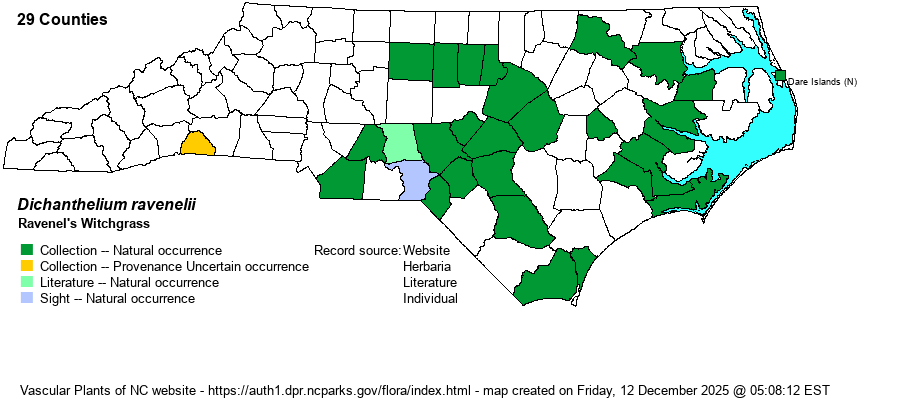| Author | (Lamson-Scribner & Merrill) Gould | |
| Distribution | Coastal Plain and Sandhills; scattered in the lower Piedmont. The gaps in the middle Coastal Plain are hard to explain. The Polk County specimen was collected "in lawns" and therefore adventive or introduced. A report from Transylvania County needs vetting.
Southern NJ to southern MO, south to northern FL and eastern TX. | |
| Abundance | Frequent in the Coastal Plain and Sandhills, but uncommon in the eastern half of the Piedmont. The website editors suggest a State Rank of S3S4. | |
| Habitat | Mesic to dry Longleaf Pine uplands, pea swales, and flats; dry to mesic pine savannas and flatwoods, mesic Piedmont hardwoods. | |
| Phenology | Flowering and fruiting May-October. | |
| Identification | This is a tall and elegant witchgrass, the stems mostly 1.5-2.5 feet tall, with 4-6 stem leaves and bearded stem nodes. The undersides of the rather large leaves are softly short-pubescent. It is hard to confuse with others in the genus, but see D. oligosanthes var. oligosanthes. | |
| Taxonomic Comments | None, other than named as Panicum ravenelii in older references.
A note about Dichanthelium: This genus is not impossible to identify to species! But it takes applied effort over a period of time in order to learn the various species and what their morphological limits are. We strongly recommend that you read the introduction to the treatment in Weakley et al. (2023), written by Richard LeBlond. LeBlond has made order out of near chaos, and his keys work very well for our plants. Most Dichanthelium taxa ("Dichs") do not grow everywhere indiscrimminately, but prefer certain well-defined habitats. Note that most species produce flowers/fruits twice a year -- a vernal period and an autumnal period -- and that measurements of spikelets and achenes are taken from vernal plants. Some species also have a third, or summer, period. In the vernal period there is a single inflorescence at the tip of the stem. In the autumnal period, plants produce elongate branches with bunched (congested) leaves and so look quite different from vernal plants. Inflorescences are produced in leaf axils as well as at the tips of branches. NOTE: Older texts had these species essentially all within the very large genus Panicum. "Dich" species are typically named as "Witchgrass" and Panicum species named as "Panicgrass". | |
| Other Common Name(s) | Ravenel's Rosette-grass | |
| State Rank | S3 [S3S4] | |
| Global Rank | G5 | |
| State Status | | |
| US Status | | |
| USACE-agcp | FACU link |
| USACE-emp | FACU link |

